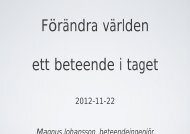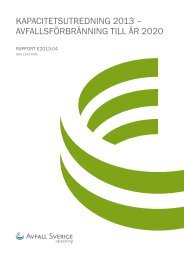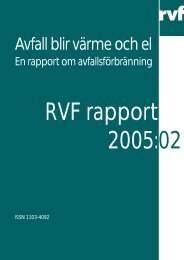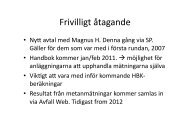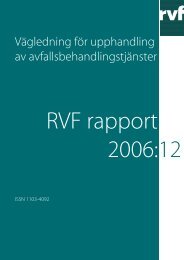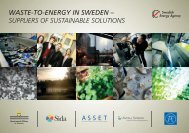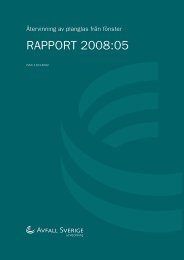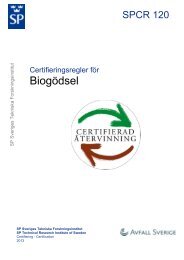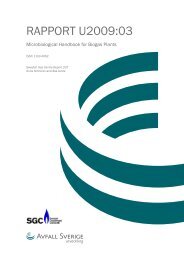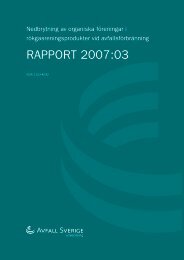2007:04 Hantering av förpackat livsmedelsavfall - Avfall Sverige
2007:04 Hantering av förpackat livsmedelsavfall - Avfall Sverige
2007:04 Hantering av förpackat livsmedelsavfall - Avfall Sverige
You also want an ePaper? Increase the reach of your titles
YUMPU automatically turns print PDFs into web optimized ePapers that Google loves.
DEWASTER ® - Sorting out the problems of mixed waste<br />
household preferences and practises unsorted MSW display a significant differences in composition<br />
from country to country or even between regions and cities within individual countries.<br />
Below is given an indication of the nature of the six fractions of waste separated during EPA study in<br />
Odense.<br />
Bulk refuse<br />
Bulk refuse consist in a variety of singular large items such as bicycle frames, plastic buckets, discarded<br />
electronic appliances etc. which are not allowed in the MSW, but placed in the MSW by mistake<br />
or through neglect.<br />
Screen fraction (pre-sorting reject)<br />
The screen fraction is very light and contains mainly plastic, paper, cardboard and textiles. The components<br />
are relatively large and intact and therefore easily recognisable. Some of the common components<br />
are plastic bags, newspapers, food packaging and diapers.<br />
Metal<br />
The metal fraction consisted in cans, bottle caps, cutlery and similar, and accounted for app. 2 percent<br />
of the total in put of MSW. The sorting quality and the type of magnet used was not optimised during<br />
the study and, thus, higher yields of metals for recycling may well be possible.<br />
Oversize<br />
A special device (DESIZER) takes out smaller hard items like non-ferro metal objects, bones,<br />
stones, ceramics and pieces of wood prior to the DEWASTER® press in order to increase press efficiency,<br />
prevent blockage and to prolong press life.<br />
Press reject<br />
The press reject is the dry fraction from the DEWASTER® screw-press. The fraction contains mainly<br />
paper- and plant fibres, plastic and non-organic components such as gr<strong>av</strong>el, glass and aluminium.<br />
There are basically three ways of disposing this fraction: Incineration in a waste incinerator, co-burning<br />
in industrial plants or composting prior to landfill. In respect to incineration and co-burning the Danish<br />
EPA study concludes that press reject due to higher ash contents (i.e. contents of incombustible nonorganic<br />
material) has a lower heat value and a higher level of alkali metals and glass particles than<br />
<strong>av</strong>erage MSW, but a lower level of chloride<br />
Bio pulp<br />
Bio pulp is a brown/grey pasty mush, which resemble sewage sludge, but generally without any smell<br />
of rotten material. The bio pulp is easily digestible in anaerobic processes and after addition to a bio<br />
gas reactor, an increase in gas production is typically seen within one hour.<br />
The <strong>av</strong>erage yield of bio pulp achieved during the EPA study was 23 % of the in put MSW with 29-<br />
34 % dry matter. In Odense the OFMSW accounts for app. 39 % of the total unsorted MSW. The yield<br />
of 23 % in this study means that app. 59 % of the organic material was sorted out of the MSW. This is<br />
page 6 of 9



